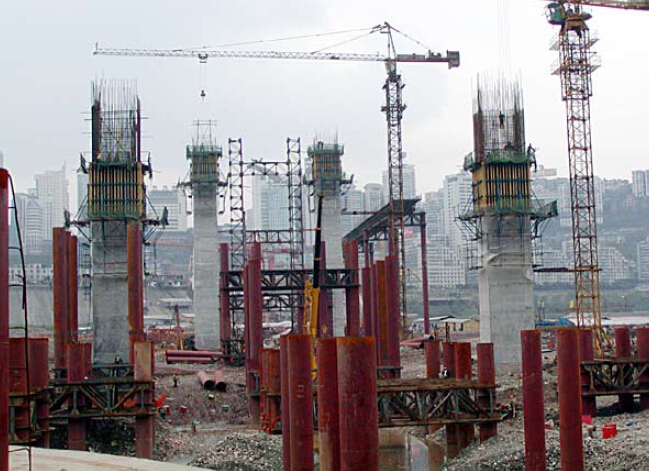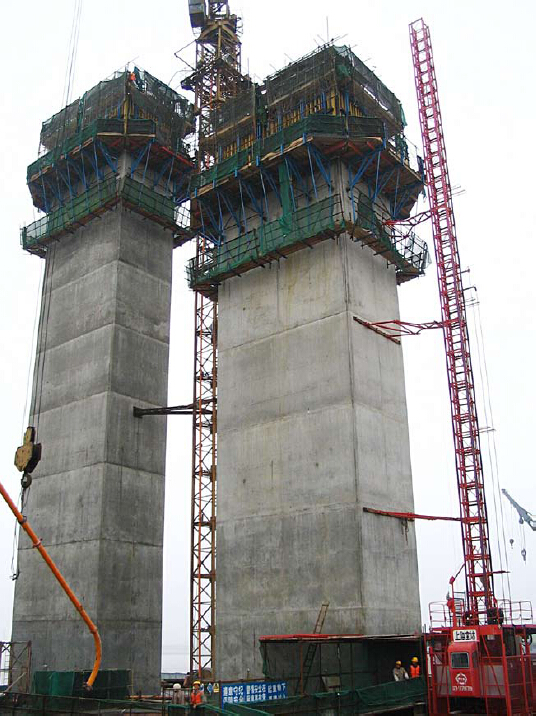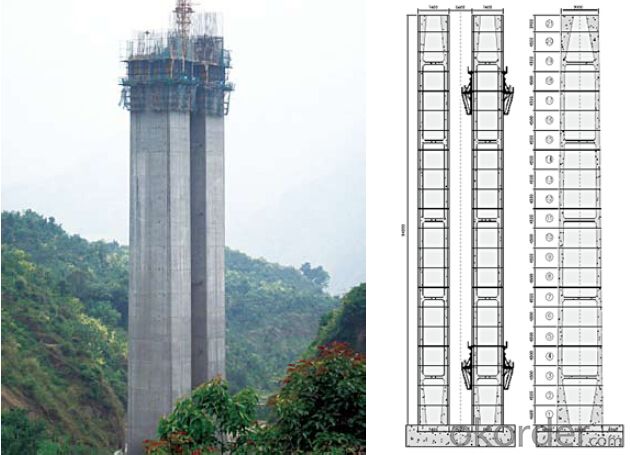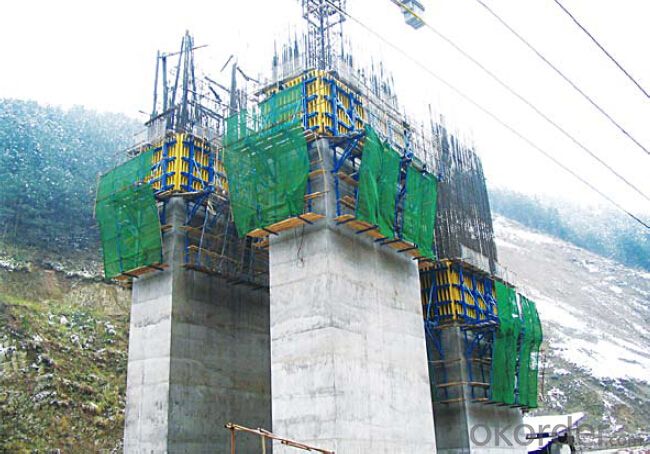Climbing-bracket CB-240 for formwork and scaffolding systems
- Loading Port:
- Tianjin
- Payment Terms:
- TT OR LC
- Min Order Qty:
- 50 m²
- Supply Capability:
- 1000 m²/month
OKorder Service Pledge
OKorder Financial Service
You Might Also Like
Climbing Bracket CB240 & CB210
They are framework brackets for supporting large-area wall formwork.
Typical applications for the CB240&CB210 are pier and column/shear wall/core walll/ in the
building.
CB210 has smaller size than CB240, it will be cost effective in some condition.
Characteristics:
◆ High bearing capacity
The high loading capacity of the brackets allow very large scaffold units. This saves the number
anchor points required as well as reducing climbing times.
◆ Simple moving procedure by crane
Through the strong connection of formwork together with the climbing scaffold, both can be moved
as a single climbing unit by crane. Thus valuable time-savings can be achieved.
◆ Fast striking process without a crane
With the retrusive set, large formwork elements can also be retracted quickly and a minimum of
effort.
◆ Safe with work platform
The platforms have assembled firmly with bracket and will be climbing together, without scaffolding
but can work safely in spite of your high location.


- Q: How does steel formwork handle different concrete surface texture requirements?
- Steel formwork is highly versatile and can easily handle different concrete surface texture requirements. The steel panels used in formwork can be easily adjusted and manipulated to create different textures, such as smooth or textured finishes, depending on the desired outcome. The steel panels can also be treated or coated to enhance the surface texture or prevent sticking, ensuring a consistent result. Additionally, steel formwork is durable and can withstand the pressure and vibrations associated with different concrete pouring techniques, further accommodating various surface texture requirements.
- Q: Can steel formwork be used for both small and large concrete pours?
- Yes, steel formwork can be used for both small and large concrete pours. Steel formwork provides durability, strength, and stability, making it suitable for various sizes of concrete pours. Its versatility allows for easy customization and adjustment to accommodate different project requirements.
- Q: How does steel formwork handle different concrete early age strength development?
- Steel formwork is a versatile and durable material that is commonly used in construction for shaping and supporting concrete structures. When it comes to handling different concrete early age strength development, steel formwork demonstrates several advantages. Firstly, steel formwork provides excellent support and stability to the concrete during the initial stages of its curing process. This is crucial as the concrete gains strength and begins to harden. The rigid nature of steel formwork prevents any deformation or displacement, ensuring that the concrete retains its desired shape and structure as it sets. Additionally, steel formwork offers a high level of dimensional accuracy. This means that it can provide precise and consistent shapes and sizes to the concrete elements being constructed. This is particularly important during the early age strength development phase, as any variations or inconsistencies in the formwork could negatively impact the overall strength and integrity of the concrete. Furthermore, steel formwork is highly resistant to moisture and chemical reactions. Concrete undergoes a hydration process, where it absorbs water and undergoes chemical reactions to gain strength. Steel formwork, being non-absorbent, prevents excessive moisture from being absorbed by the concrete, which could lead to reduced strength development or even cracking. Additionally, steel formwork does not react chemically with the concrete, ensuring that the desired early age strength development is not compromised. Another advantage of steel formwork is its reusability. Unlike other formwork materials such as wood or plastic, steel formwork can be easily dismantled and reused for multiple construction projects. This not only reduces construction costs but also allows for consistent and reliable formwork performance, regardless of the concrete's early age strength development requirements. In conclusion, steel formwork is a reliable and efficient solution for handling different concrete early age strength development. Its stability, dimensional accuracy, resistance to moisture and chemical reactions, as well as its reusability, make it an ideal choice for shaping and supporting concrete structures during the crucial initial stages of curing.
- Q: How does steel formwork handle concrete pumping and placing?
- Steel formwork is a highly durable and versatile construction material that is well-suited for handling concrete pumping and placing. Due to its strength and rigidity, steel formwork can withstand the pressure exerted by the concrete during the pumping process without any deformations or failures. It provides a stable and secure framework, ensuring that the concrete is accurately placed and consolidated. Steel formwork also offers excellent resistance to the abrasiveness and corrosiveness of concrete. This is especially important during the pumping and placing stages, as the concrete is often mixed with various additives and can have a high alkaline content, which can be destructive to other types of formwork materials. However, steel formwork is unaffected by these chemical reactions, making it a reliable choice for handling concrete pumping and placing. Moreover, steel formwork is easily adjustable and adaptable, allowing for the creation of complex shapes and designs. It can be easily assembled and disassembled, enabling efficient and quick reconfiguration of the formwork system to accommodate different concrete pumping and placing requirements. This flexibility makes steel formwork a preferred choice for projects that involve intricate or customized concrete structures. Additionally, steel formwork provides a smooth and consistent surface finish to the concrete, ensuring that the final structure meets the desired aesthetic and functional requirements. The rigid nature of steel formwork helps prevent any deformations or irregularities in the concrete surface, resulting in a high-quality and visually appealing end product. In summary, steel formwork is an ideal choice for handling concrete pumping and placing due to its strength, durability, resistance to chemical reactions, adaptability, and ability to provide a smooth finish. It offers a reliable and efficient solution for construction projects that require accurate and precise concrete placement.
- Q: Can steel formwork be used for retaining walls?
- Retaining walls can indeed utilize steel formwork. The popularity of steel formwork for retaining walls stems from its robustness and resilience. It effectively bolsters and stabilizes the concrete throughout the construction phase. The steel formwork's ability to withstand the immense pressure exerted by both the concrete and the soil behind the retaining wall guarantees the structural integrity of the wall. Moreover, the versatility of steel formwork enables the creation of diverse retaining wall designs, as it can adapt to different shapes and sizes. Ultimately, steel formwork proves to be a dependable and efficient choice for retaining walls, ensuring durability and ease of construction.
- Q: Can steel formwork be used for both interior and exterior concrete placement?
- Yes, steel formwork can be used for both interior and exterior concrete placement. Steel formwork is known for its durability and strength, making it suitable for various construction projects. It provides a stable and rigid structure that can withstand the pressure and weight of the concrete during the pouring and setting process. Moreover, steel formwork can be easily assembled and disassembled, allowing for efficient use in both interior and exterior applications. Whether it is for building walls, columns, slabs, or other concrete elements, steel formwork offers a versatile solution that can be used in different environments and conditions.
- Q: How does steel formwork handle formwork stability during concrete pouring?
- Steel formwork provides excellent formwork stability during concrete pouring due to its high strength and rigidity. It can withstand the pressure and weight of the fresh concrete without deformation or collapse, ensuring the desired shape and structure of the concrete elements. Additionally, steel formwork can be easily adjusted and secured in place, allowing for precise alignment and stability during the pouring process.
- Q: How does steel formwork contribute to the overall durability of a structure?
- Steel formwork contributes to the overall durability of a structure by providing a strong and rigid framework during the concrete pouring process. It ensures accurate and precise shaping of the concrete, resulting in a solid and uniform structure. Steel formwork is highly resistant to warping, bending, and cracking, making it more durable than other types of formwork materials. Its strength and durability allow for multiple reuse, reducing construction costs and minimizing waste. Additionally, steel formwork provides excellent support for the concrete as it cures, preventing any deformation or collapse. Overall, steel formwork plays a crucial role in enhancing the longevity and robustness of a structure.
- Q: Can steel formwork be used for precast concrete walls?
- Yes, steel formwork can be used for precast concrete walls. Steel formwork provides strength, durability, and stability, making it suitable for creating high-quality precast concrete walls. Its versatility allows for a wide range of designs and shapes, making it a popular choice in the construction industry.
- Q: Can steel formwork be used for both regular and irregular concrete structures?
- Yes, steel formwork can be used for both regular and irregular concrete structures. Steel formwork is highly versatile and can be easily customized to fit any shape or size of the structure. This makes it suitable for constructing both regular structures with standard dimensions as well as irregular structures with unique shapes and designs. The flexibility of steel formwork allows for efficient construction of various types of concrete structures, including walls, columns, beams, slabs, and even complex architectural features. Additionally, steel formwork offers high strength and durability, ensuring that it can withstand the pressure and weight of the concrete during the pouring and curing process, regardless of the structure's regular or irregular shape. Overall, steel formwork is a reliable and adaptable choice for constructing both regular and irregular concrete structures.
Send your message to us
Climbing-bracket CB-240 for formwork and scaffolding systems
- Loading Port:
- Tianjin
- Payment Terms:
- TT OR LC
- Min Order Qty:
- 50 m²
- Supply Capability:
- 1000 m²/month
OKorder Service Pledge
OKorder Financial Service
Similar products
Hot products
Hot Searches




















